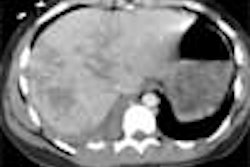CHICAGO - Using multiple technologists at a time to improve patient throughput on a single CT scanner can add significant profits to its operation, according to a study presented Monday at the 2004 RSNA scientific sessions.
Dr. Giles Boland, vice chairman of radiology at Massachusetts General Hospital in Boston presented the numbers from his study of "two-tech" and "three-tech" models for CT scanner management. His institution has already adopted this approach.
"By adding a technologist for a small incremental cost ... you gain 10 times the revenue," Boland reported.
"If you do the math, we've come out about $3.5 million ahead by using a three-tech model," Boland said. "We actually use a two- to three-tech model, because we have three techs during the busiest part of the day, and two techs at the front-end and evening hours."
MGH's change from a single-tech approach started with an evaluation of the tasks required to process a patient through a CT examination. The researchers identified the 20 different tasks -- including IV insertion, which isn't tasked to nurses at their institution -- and timed the process.
From the time the patient was delivered to the technologist, it took a single tech 26 minutes to complete all the tasks through to preparing the injector for the next patient, Boland reported.
When two technologists worked together and divided the tasks, it took only 14 minutes to complete a single exam, and for three technologists it took only 11 minutes.
Therefore, while a single tech could handle only 2.3 exams per hour, two techs could do 4.3 and three techs could do 5.5. Because many patients actually have multiple exams in a single visit, the average patient undergoes 1.4 exams, Boland noted.
On an annual basis, productivity would increase from 10,750 exams per year for one tech to 26,000 for three techs, said Boland, who also factored in standard limitations on operating hours.
To calculate the revenue impact Boland assumed a $300 global reimbursement for the technical and professional components of the exam -- the lowest amount that Medicare pays for a CT scan in Massachusetts.
"We took what we think is the low end of the reimbursement structure," Boland said. "In some states it can be much higher than this."
The unit cost per scan is $50, Boland said, so excluding the technologists' cost, the margin per scan is around $250.
The cost of the technologist is "both fixed and variable, depending on how many hours you operate, whether you're open on weekends," he said, although it worked out to adding around $25 per scan.
Technologist costs were based on an annual salary and benefits of $86,000 per person that included $55,000 in salary. Boland acknowledged that lower-skilled personnel could be used to do some of the tasks involved in patient throughput, but said that wasn't preferred at MGH.
"You could have a helper that maybe would reduce your costs in some way, but we wanted that person who's putting the patient on the table to be able to come back and run the scanner," he said.
In response to a question, Boland also acknowledged that the throughput he described was based on an outpatient population. However, he said that with a good flowchart of the CT process, inpatient turnaround times could also be minimized.
And he argued that the significant increase in revenue also provided an incentive for hospital administrators to address other issues affecting throughput, such as patient transport to the radiology department.
"We have dedicated radiology transporters, which is a no-brainer when you present the financials to the administration," Boland said.
Overall, "If you run your machine efficiently, it significantly contributes to the bottom line," Boland said, noting that efficient management can also eliminate the need for purchase of another scanner.
"And the beauty of all this is that it actually meets your stakeholder expectations at the same time," Boland concluded.
"You increase patient throughput, which is good for patients, less waiting time; more money for administration, a higher profit for your hospital, and of course, for your radiologists, potentially more income."
By Tracie L.
Thompson
AuntMinnie.com staff writer
November 29, 2004
Related Reading
Technology, technique help ease radiologist shortage, November 2, 2004
Making the most of CT technology through efficient workflow, June 28, 2004
Persistent marketing makes community CT center a financial success, November 30, 2000
Copyright © 2004 AuntMinnie.com




















